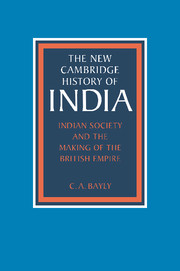Book contents
- Frontmatter
- Introduction
- 1 India in the eighteenth century: the formation of states and social groups
- 2 Indian capital and the emergence of colonial society
- 3 The crisis of the Indian state, 1780–1820
- 4 The consolidation and failure of the East India Company's state, 1818–57
- 5 Peasant and Brahmin: consolidating ‘traditional’ society
- 6 Rebellion and reconstruction
- Conclusion: the first age of colonialism in India
- Glossary of indian terms
- Bibliographical essay
- Index
- THE NEW CAMBRIDGE HISTORY OF INDIA
- Plate Section"
- References
5 - Peasant and Brahmin: consolidating ‘traditional’ society
Published online by Cambridge University Press: 28 March 2008
- Frontmatter
- Introduction
- 1 India in the eighteenth century: the formation of states and social groups
- 2 Indian capital and the emergence of colonial society
- 3 The crisis of the Indian state, 1780–1820
- 4 The consolidation and failure of the East India Company's state, 1818–57
- 5 Peasant and Brahmin: consolidating ‘traditional’ society
- 6 Rebellion and reconstruction
- Conclusion: the first age of colonialism in India
- Glossary of indian terms
- Bibliographical essay
- Index
- THE NEW CAMBRIDGE HISTORY OF INDIA
- Plate Section"
- References
Summary
The East India Company inherited on a greatly magnified scale the conflict between state entrepreneurship – the desire to squeeze up land revenue or create monopolies – and the entrepreneurship of merchant and peasant which had bedevilled many eighteenth-century Indian kingdoms. The result for the British was a long period of economic lethargy which was barely obscured by the slow introduction of the panoply of the modern state. Yet this should not be taken to imply that the early nineteenth century was an era devoid of significant social change. On the contrary, as this chapter will show, these years were critical in the creation of the modern Indian peasantry, its patterns of social divisions and its beliefs.
Many early Victorian writers were convinced that India was on the brink of a rapid transformation. Hinduism was fading in the face of evangelical Christianity; ‘caste disabilities’ suffered by the lower orders would disappear in the face of good laws; the ‘isolation’ of the Indian village would be blown apart by the impact of industrialisation. Writers in the second half of the twentieth century have dissented. Some have argued that the subcontinent was condemned to stagnation by its subjection to colonial interests – that society was frozen into caricatures of its feudal past by British land-revenue systems and the destruction of its artisan producers. Others have argued that colonial rule was peripheral to most of Indian society: it could effect changes neither for good nor ill because the new export trades were fitful and the waves of reform and regeneration were merely paper debates conducted in the corridors of Government House, Calcutta.
- Type
- Chapter
- Information
- Indian Society and the Making of the British Empire , pp. 136 - 168Publisher: Cambridge University PressPrint publication year: 1988
References
- 2
- Cited by

